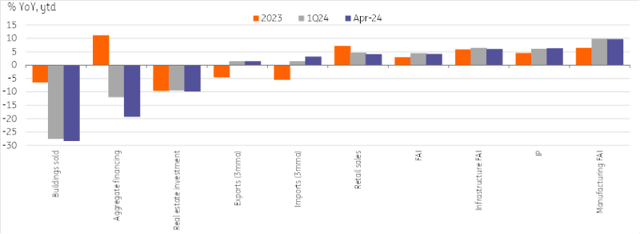Nikada
By Lynn Song
Weak confidence continued to drag growth
China saw a mixed bag in terms of data releases over the past month, but most indicators came in weaker than market forecasts.
The key theme for the month was both the private sector and households remaining cautious. Credit data showed that aggregate financing declined for the first time since 2005, and M2 growth also fell to record lows. After a strong 2023, credit contracted sharply in 2024. Our view is that real interest rates remain too high for the current state of the economy, and believe there are rising odds for monetary easing over the next several months.
Retail sales showed that consumers also remained cautious, falling to a new post-pandemic low of 2.3% year-on-year. Consumers have shied away from big-ticket purchases in favour of the “eat, drink, and play” categories.
Fixed asset investment also disappointed on the month, falling to 4.2% YoY year-to-date largely due to a drag from private sector investment, which grew a tepid 0.3% YoY YTD. With property prices seeing a sharp decline in April and developer sentiment breaking new lows, it was unsurprising to see that real estate investment remained a major overhang at -9.8% YoY YTD.
China’s high-tech transition offers a silver lining
A silver lining could be the transition toward high-tech development, which continues to drive pockets of strong growth.
One aspect of this transition could be seen in the recovery of industrial activity. Industrial production rose to 6.7% YoY in April, driven by high-tech manufacturing (11.3%), computers, communications and other electronic equipment (15.6%) and auto (16.3%). May’s manufacturing PMI data showed conflicting signs for upcoming momentum, with the official PMI notably falling into contraction at 49.5, while the Caixin PMI hit a seven-month high of 51.7 – although both surveys indicated a slowdown in new orders.
Imports also beat expectations for the month, reaching 8.4% YoY, thanks to AI-related demand boosting automatic data processing equipment, integrated circuits, and high-tech product imports. As China’s economic transitions continue, these areas should continue to see relatively robust growth.
China’s growth has been unbalanced this year
CEIC, ING
Policy rollout has accelerated amid growth stabilisation push
Policy announcements stole the thunder from China’s Data Dump Day. Policymakers ramped up supportive measures to try to stabilise the property market, and the central government kicked off its RMB1tr ultra-long-term bond issuance.
New measures over the past month included removing the floor on mortgage rates, reducing the downpayment ratios, removing purchase restrictions, and announcements of direct housing purchases to help absorb excess inventories. Banks have continued to provide support for ailing property developers.
The increased aggressiveness of policy support has supported markets over the past month and showed further commitment towards growth stabilisation. There has been growing optimism in markets that we will see housing prices in Tier 1 and 2 cities bottom out in the coming months. While this is arguably the most important development in stabilising domestic confidence, it is also the first step and there is still more to be done. July’s Third Plenum meeting will likely provide further details on the longer-term policy direction, with goals of further deepening reforms and promoting the modernisation of China. Comments from President Xi indicated that the meeting may include measures on supporting property, employment, and childcare.
Content Disclaimer
This publication has been prepared by ING solely for information purposes irrespective of a particular user’s means, financial situation or investment objectives. The information does not constitute investment recommendation, and nor is it investment, legal or tax advice or an offer or solicitation to purchase or sell any financial instrument. Read more
Original Post
